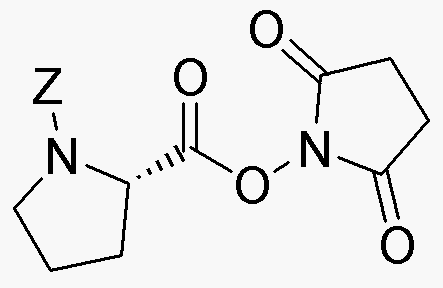Z-L-proline N-hydroxysuccinimide ester is widely utilized in research focused on:
- Peptide Synthesis: This compound serves as a valuable reagent in the synthesis of peptides, enabling researchers to create complex structures with high specificity and yield.
- Drug Development: It plays a crucial role in the development of pharmaceuticals, particularly in the design of prodrugs that enhance bioavailability and therapeutic efficacy.
- Bioconjugation: The compound is used in bioconjugation processes, allowing for the attachment of biomolecules to surfaces or other molecules, which is essential in creating targeted drug delivery systems.
- Protein Modification: Researchers utilize it to modify proteins, improving their stability and functionality, which is particularly beneficial in therapeutic applications.
- Diagnostic Applications: It is also applied in the development of diagnostic tools, enhancing the sensitivity and specificity of assays used in clinical settings.
General Information
Properties
Safety and Regulations
Applications
Z-L-proline N-hydroxysuccinimide ester is widely utilized in research focused on:
- Peptide Synthesis: This compound serves as a valuable reagent in the synthesis of peptides, enabling researchers to create complex structures with high specificity and yield.
- Drug Development: It plays a crucial role in the development of pharmaceuticals, particularly in the design of prodrugs that enhance bioavailability and therapeutic efficacy.
- Bioconjugation: The compound is used in bioconjugation processes, allowing for the attachment of biomolecules to surfaces or other molecules, which is essential in creating targeted drug delivery systems.
- Protein Modification: Researchers utilize it to modify proteins, improving their stability and functionality, which is particularly beneficial in therapeutic applications.
- Diagnostic Applications: It is also applied in the development of diagnostic tools, enhancing the sensitivity and specificity of assays used in clinical settings.
Documents
Safety Data Sheets (SDS)
The SDS provides comprehensive safety information on handling, storage, and disposal of the product.
Product Specification (PS)
The PS provides a comprehensive breakdown of the product’s properties, including chemical composition, physical state, purity, and storage requirements. It also details acceptable quality ranges and the product's intended applications.
Certificates of Analysis (COA)
Search for Certificates of Analysis (COA) by entering the products Lot Number. Lot and Batch Numbers can be found on a product’s label following the words ‘Lot’ or ‘Batch’.
*Catalog Number
*Lot Number
Certificates Of Origin (COO)
This COO confirms the country where the product was manufactured, and also details the materials and components used in it and whether it is derived from natural, synthetic, or other specific sources. This certificate may be required for customs, trade, and regulatory compliance.
*Catalog Number
*Lot Number
Safety Data Sheets (SDS)
The SDS provides comprehensive safety information on handling, storage, and disposal of the product.
DownloadProduct Specification (PS)
The PS provides a comprehensive breakdown of the product’s properties, including chemical composition, physical state, purity, and storage requirements. It also details acceptable quality ranges and the product's intended applications.
DownloadCertificates of Analysis (COA)
Search for Certificates of Analysis (COA) by entering the products Lot Number. Lot and Batch Numbers can be found on a product’s label following the words ‘Lot’ or ‘Batch’.
*Catalog Number
*Lot Number
Certificates Of Origin (COO)
This COO confirms the country where the product was manufactured, and also details the materials and components used in it and whether it is derived from natural, synthetic, or other specific sources. This certificate may be required for customs, trade, and regulatory compliance.


